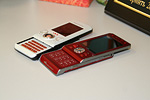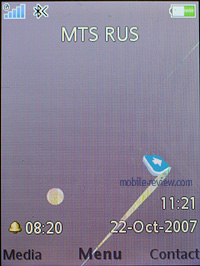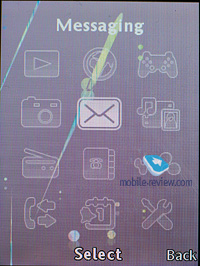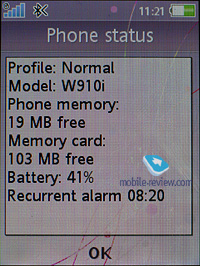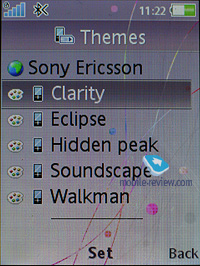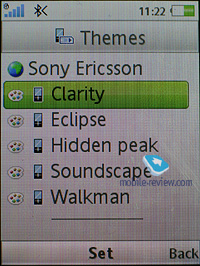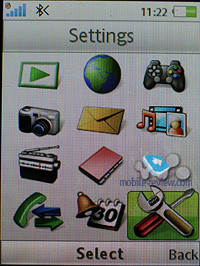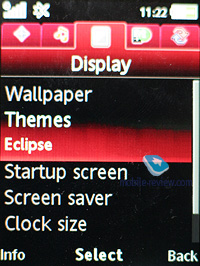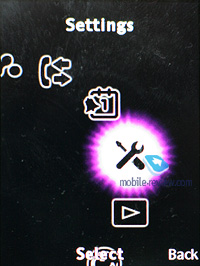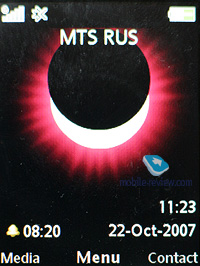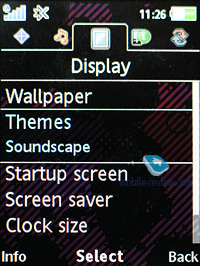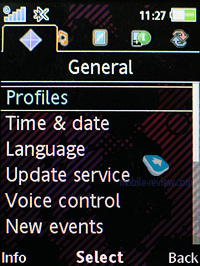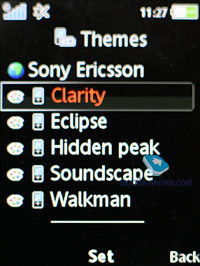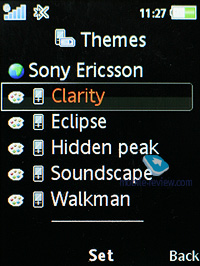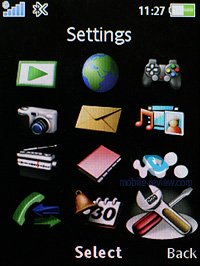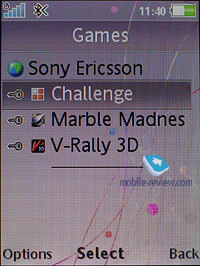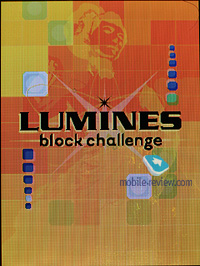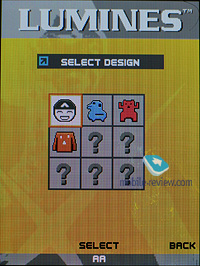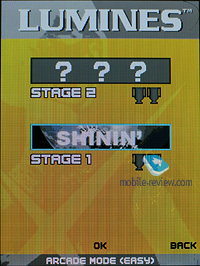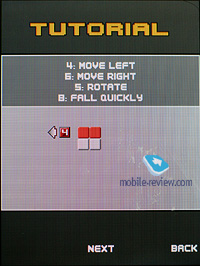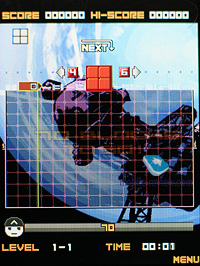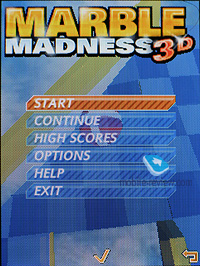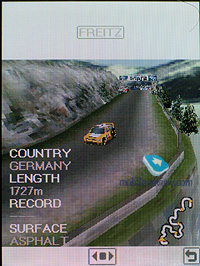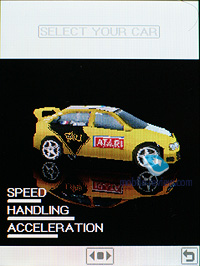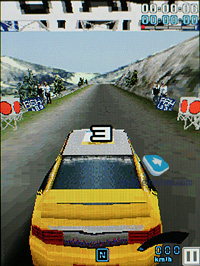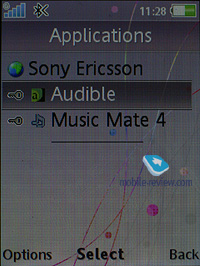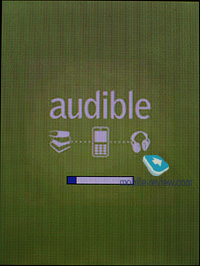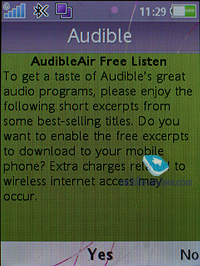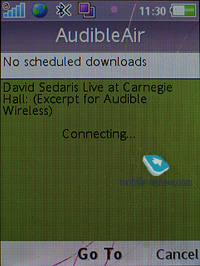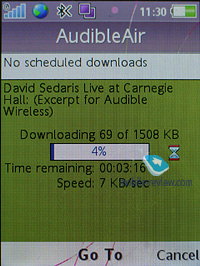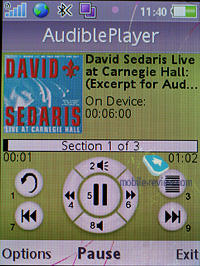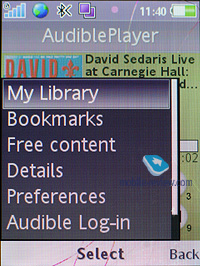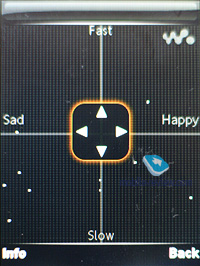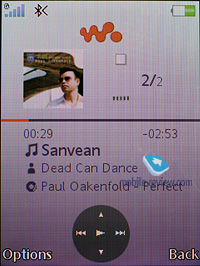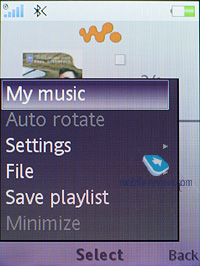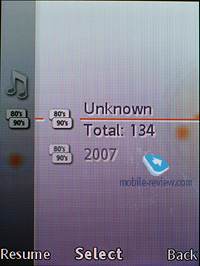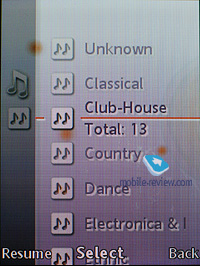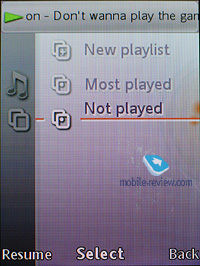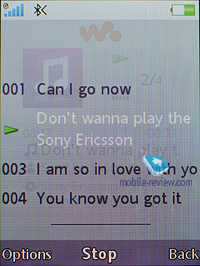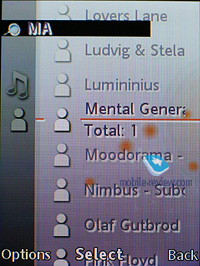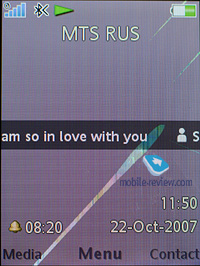|
|
Review of GSM-UMTS-handset Sony Ericsson W910i
Live photos of Sony Ericsson W910i
Table of contents:
- Positioning
- Design, size, controls
- Display
- Keypad
- Battery
- Memory, memory card
- Connectivity
- Performance
- Camera
- Preinstalled applications, games and themes
- Music department
- Sony Ericsson W910i vs Sony Ericsson W580i
- Competition
- Impressions
Sales package
- Handset
- Battery
- USB data cable
- 1 Gb M2 memory card
- USB adapter for memory cards
- Wired headset (HPM-70)
- User Guide
- Software CD
Positioning
Looking at Sony Ericsson’s portfolio, you will notice that the Sony Ericsson W910i continues the line of the Sony Ericsson W850i. These two models come housed in a slider-type design, both are flagships as far as those solutions beyond UIQ are concerned. But back in the times of the Sony Ericsson W850i its leadership as a music playing solution was questioned, for technically it was the Sony Ericsson W950i that was on top of this range both functionality- and sound-wise. As of today, however, it is all different and the Sony Ericsson W910i trumps the W960i in terms of what it packs under its hood, and it can well be considered as the company’s flagship that actually sets the development course. At the end of the day, it turns out that the W910i is the best Walkman you can get these days on the market.
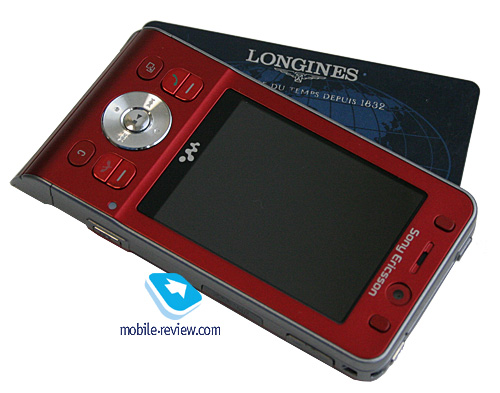
Based on this positioning, this model shouldn’t have any other device standing above it, and the truth is, there are none. The Sony Ericsson W890i comes as close to the W910i as it gets, but it utilizes a candybar-shaped form, and this is a fashion-savvy branch of the Walkman line-up. That is why its closest sibling in the range is the Sony Ericsson W580i, since they share a lot of things, specifically they both have pedometers onboard, Shake Control options, even though the W580i doesn’t have much of the latter.
Curiously, in many ways the Sony Ericsson W910i was designed to battle against Samsung’s slim sliders, for example the D900. While this thought won’t even come across your mind at a glance, you’ll definitely get it if you put two phones face to face. Another thing of note is that even in its U-series Samsung has ditched the hallmark design of the Samsung D900. These days there is no direct competition going on between the W910i and Samsung’s solutions, only some indirect clashes like with the Samsung i450 (a slider blowing you away with its sound quality), the Samsung F330 (close in terms of positioning). Also, we could list the Samsung U600/U700 as its rivals, but these two come from a different class and don’t really give the W910i a run for its money.
Back to the table of contents >>>
Design, size, controls
The W910i measures in at 99.5x50.12.5 mm and tips our scales at 86 grams, being a slender, yet a pretty wide phone that turns out to be pretty much palm-friendly. The spring-loaded mechanism does well, even though there is no thumb rest on the W910i, and your finger usually ends up on the display. The casing is made mainly of plastic, which is the reason why it is a lightweight. We have no gripes with the phone’s plastic even after a month of quality time with it – no scuffs, no scratches or other apparent types of damage.

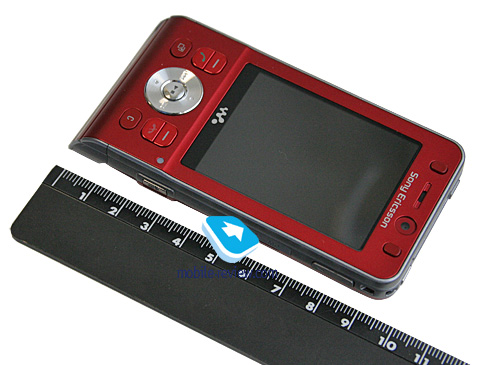

This model’s prototypes had one problem in common – the halves sat too tight, and the upper slide’s inner side was greatly exposed to wear and tear. But thankfully, before the W910i got onto the production line, this flaw had been dealt with. And to put our worries to rest, we zipped it open/closed 15 thousand times, which is obviously a mere drop in the ocean compared to what they to at the maker’s facilities – like 100 hundred thousand or so. Still, our unit had no scuffs whatsoever on that problem place – at least, we couldn’t spot them with our eyes. Of course these is a good chance that we would have seen them if we had been looking through a magnifier or just staring at the W910i.
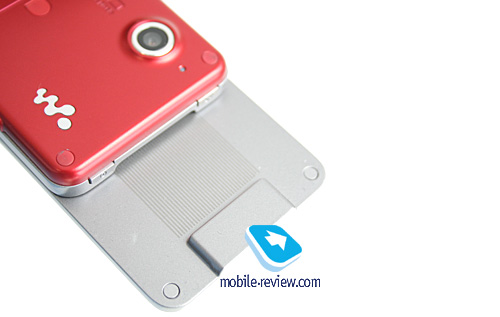
The handset employs relatively thin plastic, whose worst fears are extreme stresses, like drop impacts. Nobody is a hundred percent safe as far as these accidents are concerned, but with the W910i, expect to see the shell peel off, especially in places where two or more details meet. This type of damage becomes obvious when you examine the display’s plastic rim. Nevertheless, the plastic’s base color isn’t that much different in color, so these scratches and splits won’t grab your eyes.
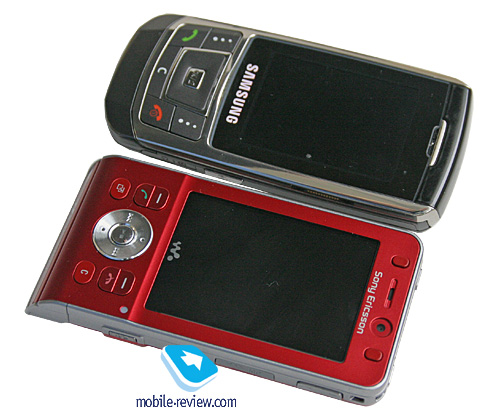
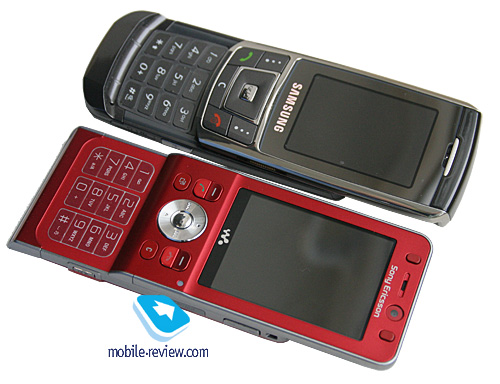
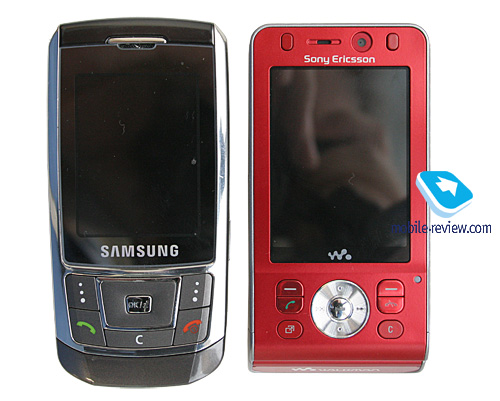

The phone is available in a choice of three colors: Hearty Red, Noble Black and Havana Bronze. Exclusive editions for local carriers may show off other flavors as well, like blue. However, the latter aren’t likely to be readily available in the future.
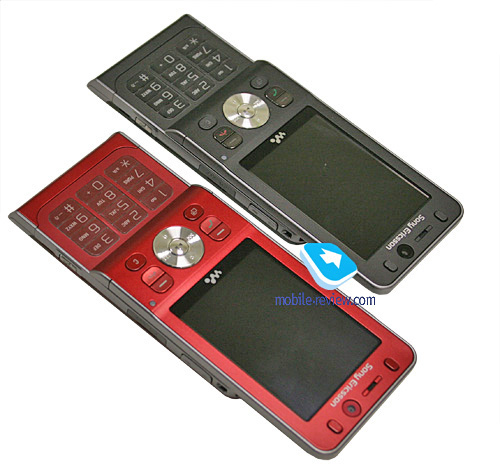
The headset’s microphone area and earbud plates are color-keyed to the casing’s trim. While previously we saw only standard-color headsets included with phones, the W910i enjoys a happy harmony color-wise.
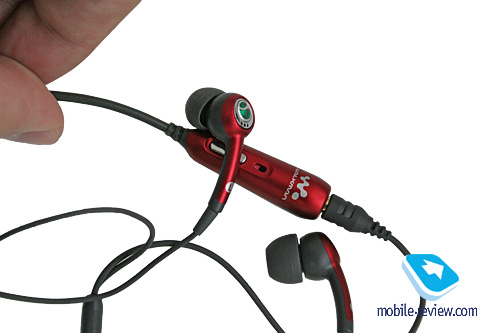

Every color scheme the W910i comes in is eye-candy – the red will appeal to women, the bronze is pretty much unisex and has a lot of style going for it in real life. And the black is what most models look nice in.
The top end of the phone rooms a power button, as well as a Walkman button, whose strange placement is due to the Shake Control feature that kicks in when holding this key down. And since this ability is (obviously) used when you don’t have your eyes on the phone, the button sits on the place, where you can find it by touch pretty much effortlessly.
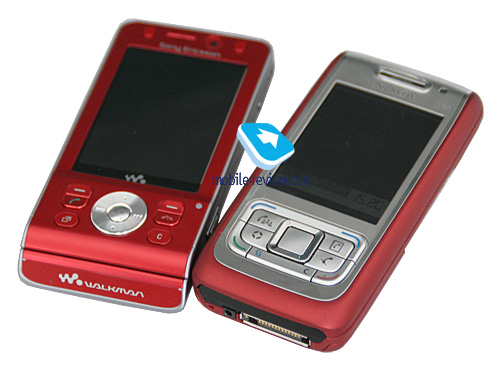
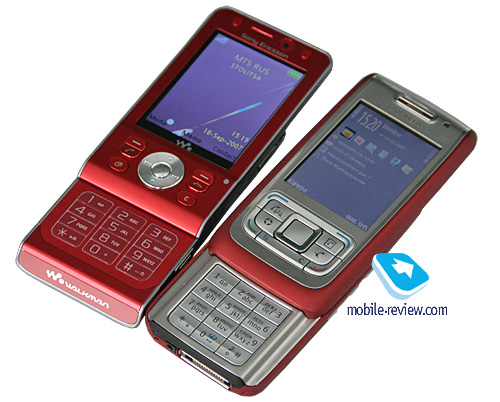

The bottom edge has a sleek slope, which makes the W910i appear to be taller than it is. Flipping over to the rear, you will see that the loudspeaker has been lifted up with a sliver plate, so when you have the W910i lying face-up on the table this makes the phone louder. At the top of the underside there are some rubber pads protecting the casing from getting scratches and scuffed.

The left-hand spine hosts a standard interface socket – Fast Port, and the lanyard loop has been relocated to the right side, where you also can find a moderately sized volume rocker, which is not always a joy to use. A dedicated camera button alongside a M2 memory expansion slot sit here as well.
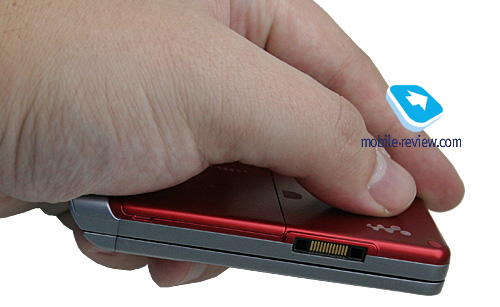
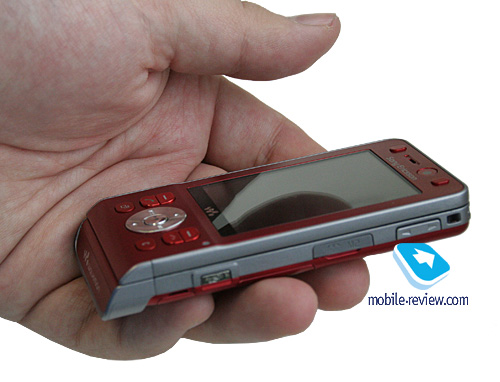
The only thing we have left to say is that the rear houses a 2 Mpix camera lens, a LED recording indicator (glows in red when recording a video clip) and a slider switch that locks the battery cover.

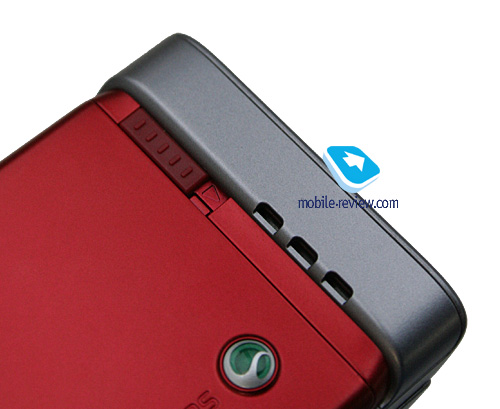
Atop the display is a forward-facing VGA camera for video calls. Another thing I would like to highlight here is the SIM-card slot mounted in the battery compartment – it slides in pretty seamlessly, however taking it out is quite a challenge.
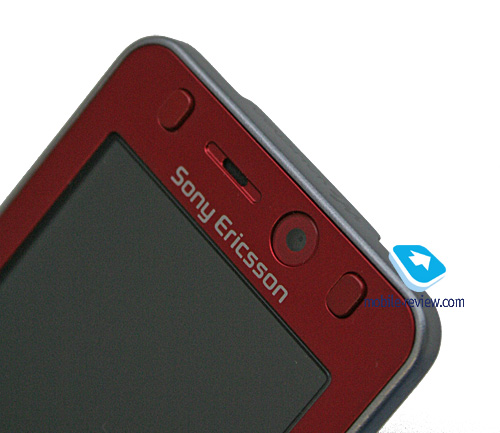
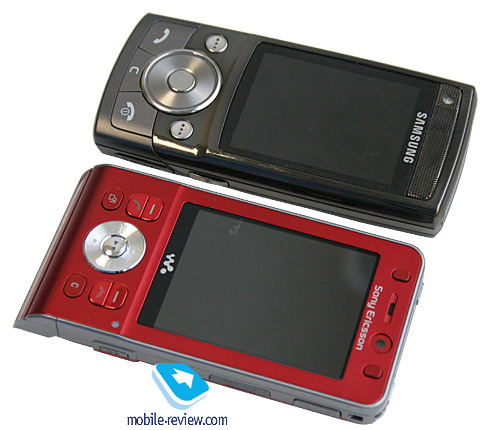

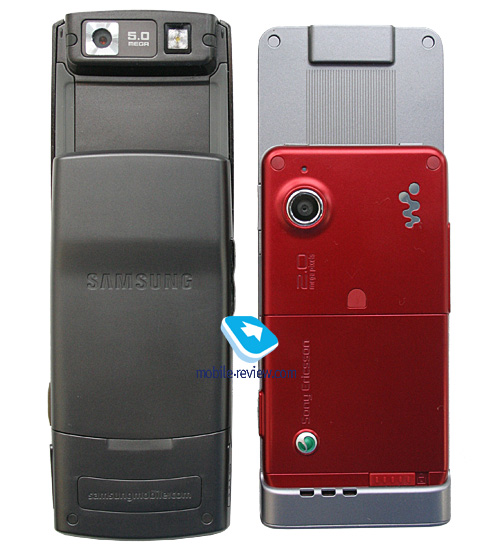

Back to the table of contents >>>
Display
The W910i comes installed with a 240x320-pixel display (2.36-inch diagonal, 36x48 mm) that can show up to 262 K colors. The picture you get with it is pretty decent – bright and smooth, and the truth is, in terms of color reproduction, this one is among the market’s finest. Its sizable diagonal renders all fonts large and very readable, which is especially notable when facing it off against other Sony Ericsson branded phones enjoying 2-inchs screens. For example, comparing the W910i with the Sony Ericsson W580i you will surely see that the former is nearly no different from the W580i, even though its larger diagonal could have done a lot worse here. Luckily it is not the case with the W910i and thus its display looks pretty much like a winner.
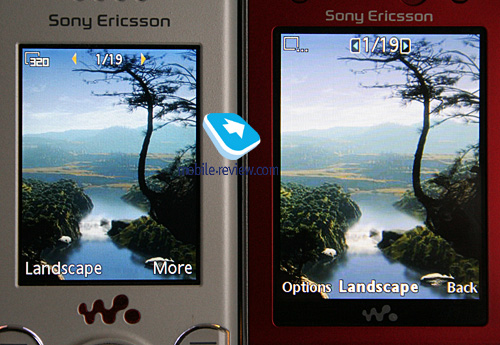
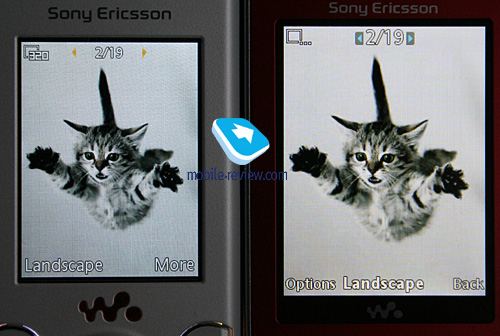

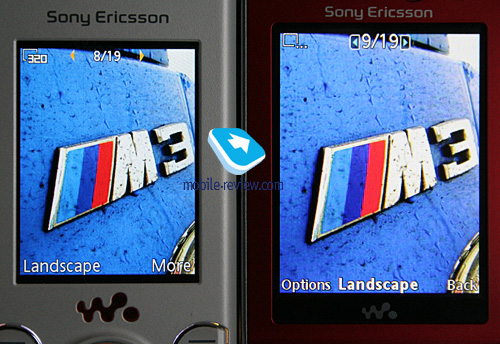
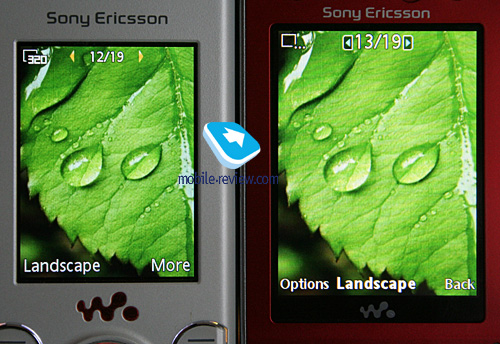
The display accommodates up to 9 text and 4 service lines, some modes might even squeeze more lines of information into it. This screen also is pretty good at handling direct sunlight and makes for easy reads on the go.
Back to the table of contents >>>
Keypad
The navigation cluster is styled after the company’s latest and greatest models, meaning that it now houses pick/hang up buttons, and the user interface is generally designed to be managed with three soft-keys. The W910i’s face also sports a “C” button and a dedicated Activity Menu key.
The four-way navigation key has all basic player controls engraved on it, and the OK button is chromed. On the whole, these two are pretty much a breeze to handle, we have no complaints about neither of them.
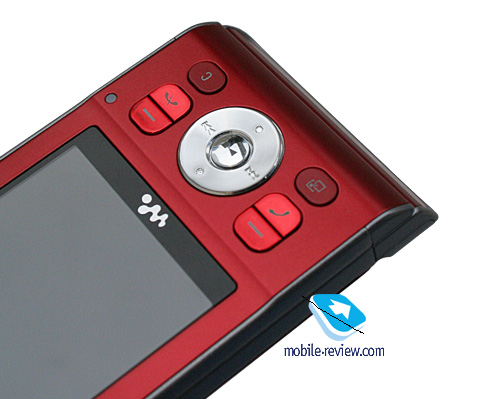
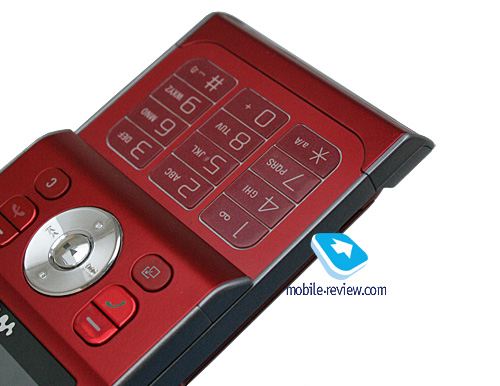
On the right sits an ambient light sensor that controls the W910i’s backlighting (white and not very bright, yet convenient). In the Walkman mode the navigation key’s rim is lit in orange.
Topping the display are two extra keys – A and B, using which you can view photos, just like you did with the Sony Ericsson K800i.
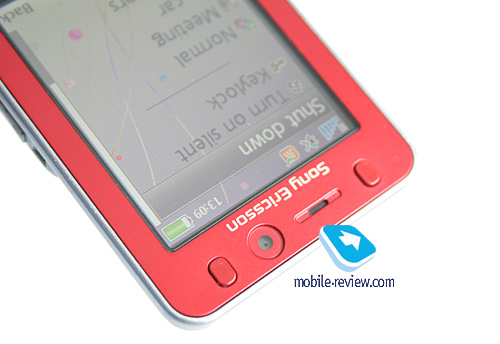
The numeric keys are made of a thin slab, and provide a very modest travel. Basically, you need to press them with your entire finger pads; this sets it apart from most other keypads. The ergonomics of this solution are not really decent, and you will need some time to get used to it. Those into texting might even find the W910i completely unsuitable.
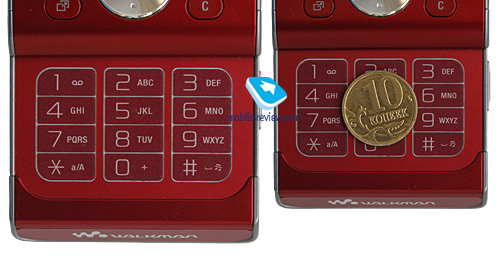
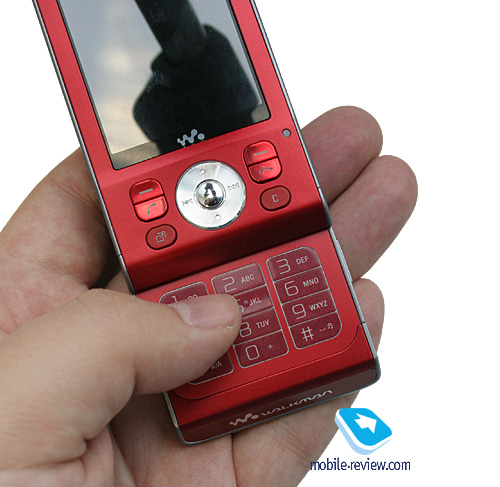
Back to the table of contents >>>
Battery
Unlike most of the previous models coming with Li-Pol cells, the W910i makes use of a 920 mAh Li-Ion battery (BST-39). As the manufacturer claims, it can keep the handset up and running up to 350 hours in standby and provide up to 9 hours of talk time.
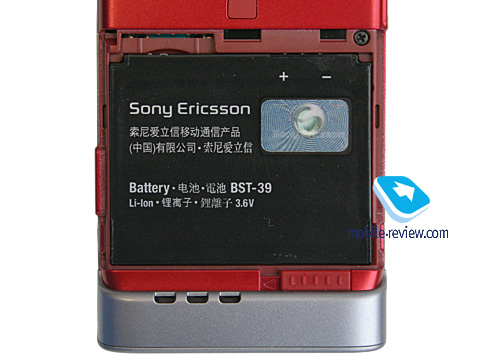
In Moscow the W910i lasted around 2,5-3 days with average use – up to one hour of calls, around 30 minutes of games, 20 minutes of browsing, a couple of hours of music. In Europe its battery performance will get at least 1,5 times better all thanks to superior coverage. We squeezed around 19.5 hours of music out of the W910i, while the maker claims it can do 20.
The W910i is remarkable for having its battery life boosted in all modes again, despite the fact that its diagonal has grown larger. Without cutting off some of its functionality, Sony Ericsson’s engineers have increased its figures from 10 to 30 percent over the previous generation of cells, like the BST-33 (Li-Pol, 900 mAh).
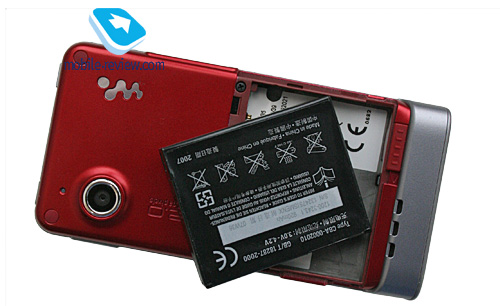
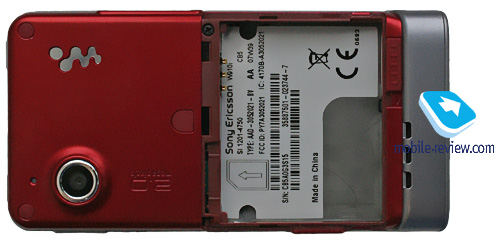
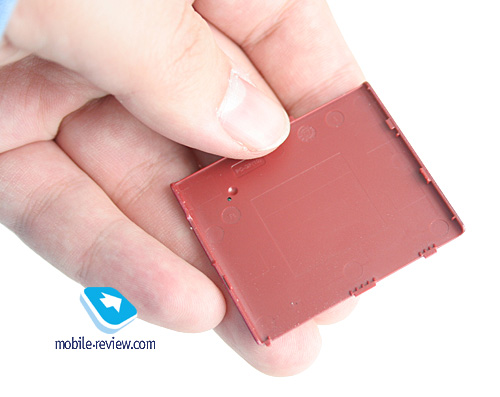
Battery life wise, the Sony Ericsson W910i trumps Samsung-branded sliders (Li-Ion, 800 mAh), as it lasts roughly 1,5-2 times longer. And its music mode is even a bigger winner – 2,5 times more juice. Similar power-saving technologies are offered only by Nokia these days – its solutions last just as long while having comparable batteries inside.
This means other makers are down to a compromise – either they increase their cell volume and thus handset’s weight, or sacrifice some of its battery life. They simply can’t get both things (size and battery life) into their phones.
It takes the Sony Ericsson W910i around 2.5 hours to charge from empty to full (1,5 hours to charge up to 80 percent).
Back to the table of contents >>>
Memory, memory card
The W910i shops with around 38 Mb of user-manageable memory, the sales package also includes a 1 Gb memory card (M2), and you can always hot swap them. The top size of your memory card that this phone can handle is 4 Gb (when more capable cards come along, it will deal with them as well).
Back to the table of contents >>>
Connectivity
USB
If you just want your W910i to turn into a modem, then pick the second option, when you will have a chance to play around with various USB settings for going online.
You can also enable auto image rotation (all thanks to the motion sensor). While the camera’s menu looks different, these changes haven’t affected its performance.
Bluetooth
The handset comes with EDR-enabled Bluetooth 2.0, the menu enables you to turn on enhanced power saving mode. There is also A2DP support, which allows employing wireless headsets with the W910i. Its data transfer speed tops out at 100 Kb/s. The list of supported profiles:
- A2DP
- Basic Imaging Profile
- Basic Printing Profile
- Dial-Up Networking Profile
- File Transfer Profile
- Generic Access Profile
- Generic Object Exchange Profile
- Handsfree Profile
- Headset Profile
- HID
- JSR-82 Java API
- Object Push Profile
- Personal Area Network Profile
- Serial Port Profile
- Service Discovery Application Profile
- Synchronization Profile
- SyncML OBEX binding
Back to the table of contents >>>
Performance
The W910i puts up typical numbers for the company’s latest generation of devices and is ahead of most models available on the market. There are no limits on JAR-file size, HEAP size – from 512 Kb to 1.5 Mb.

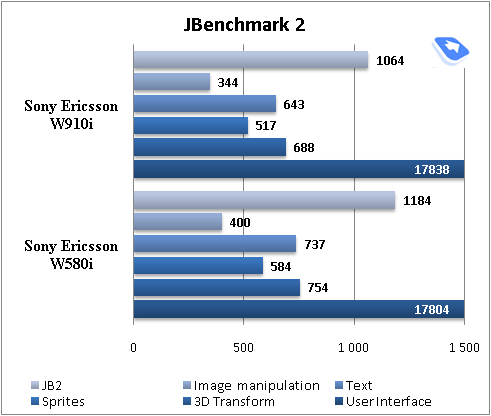
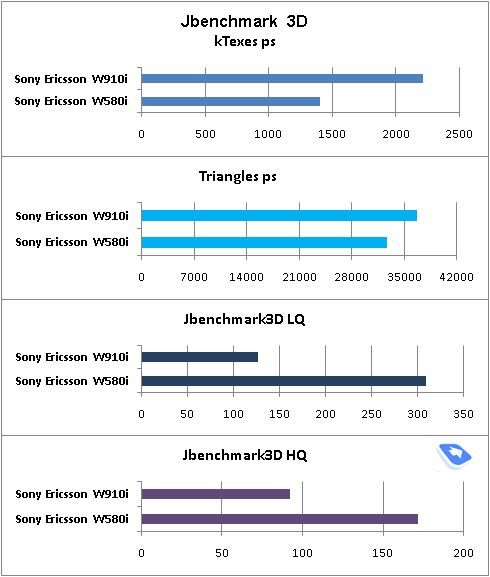
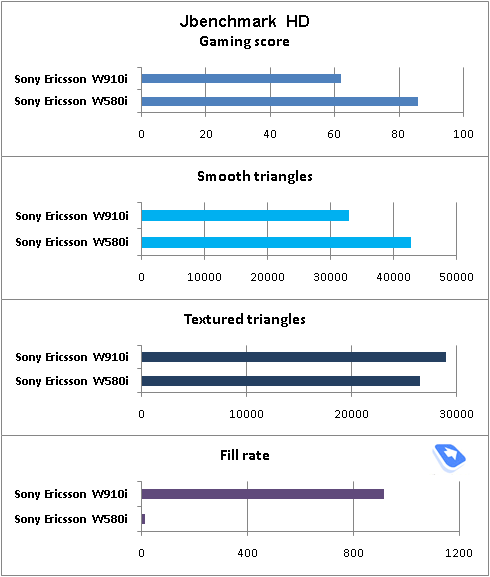
Back to the table of contents >>>
Camera
The device is equipped with a 2 MP camera with a CMOS matrix without auto-focus. The device supports three possible resolutions - 1632x1224, 640x480, 160x120 pixels. Two types of data compression (Normal and Fine) are at your disposal. The majority of the sample photos are in the Fine quality. The photos differ in size almost two times depending on the resolution. Thus a photo in the Normal mode takes up about 300 KB while the Fine quality results in 500-600 KB. Saving a photo takes the same time not depending on chosen type and makes about 1-2 seconds, and that is quite speedy for such file size. When taking several photos one after another (not in the Burst mode but just successively) then you'll notice slight slowdowns (up to 3-4 seconds). My subjective feelings tell me the device buffer includes 2 Mb of memory.

The model employs the new Cyber-Shot interface, which is indicated by its dedicated Settings menu. You can also enabled auto image rotation (all thanks to the motion sensor). While the camera’s menu looks different, these chances haven’t affected its performance.
The camera settings look in the following way:
- Shutter sound. You can choose one of the three shutter sounds but not turn the sound off.
- White balance. A possibility to choose between an auto-mode, Incandescent, Fluorescent, Daylight.
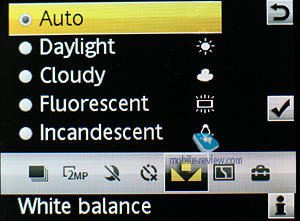
- Effects. Several effects may be applied to the photos. These are Negative, Solarize, Sepia, Black & White.
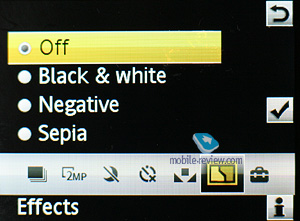
- Timer is activated for a certain time period for self shooting.
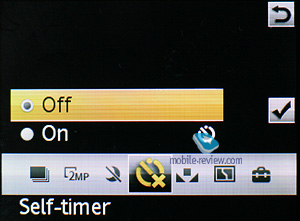
- Night mode is for shooting in the dark. Noises raise on a photo, exposure time gets increased (you shouldn't move the device in order not to get a blurry photo).
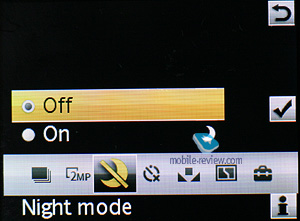
- Shooting mode. Normal mode that takes ordinary photos. Multishot-mode (Burst 4) allows taking four photos in a series. Landscape is a very interesting mode that allows taking rather fetching photos; the market hasn’t seen anything similar to date yet. The last mode is taking photos with frames, photo resolution is decreased automatically.

The screen serves as a viewfinder while in the shooting mode. The picture moves very smoothly, details don’t get dropped out. Numeric keys help in switching between various functions and shooting parameters quickly that speeds up the phone’s operation.
 |
 |
| (+) maximize, 1600õ1200, JPEG |
(+) maximize, 1600õ1200, JPEG |
 |
 |
| (+) maximize, 1600õ1200, JPEG |
(+) maximize, 1600õ1200, JPEG |
 |
 |
| (+) maximize, 1600õ1200, JPEG |
(+) maximize, 1600õ1200, JPEG |
 |
 |
| (+) maximize, 1600õ1200, JPEG |
(+) maximize, 1600õ1200, JPEG |
 |
 |
| (+) maximize, 1600õ1200, JPEG |
(+) maximize, 1600õ1200, JPEG |
 |
 |
| (+) maximize, 1600õ1200, JPEG |
(+) maximize, 1600õ1200, JPEG |
 |
 |
| (+) maximize, 1600õ1200, JPEG |
(+) maximize, 1600õ1200, JPEG |
 |
 |
| (+) maximize, 1600õ1200, JPEG |
(+) maximize, 1600õ1200, JPEG |
 |
 |
| (+) maximize, 1600õ1200, JPEG |
(+) maximize, 1600õ1200, JPEG |
 |
 |
| (+) maximize, 1600õ1200, JPEG |
(+) maximize, 1600õ1200, JPEG |
 |
 |
| (+) maximize, 1600õ1200, JPEG |
(+) maximize, 1600õ1200, JPEG |
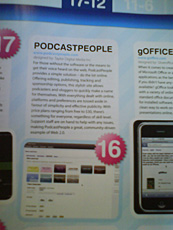 |
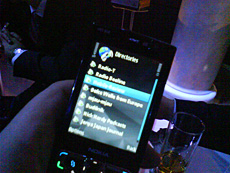 |
| (+) maximize, 1600õ1200, JPEG |
(+) maximize, 1600õ1200, JPEG |
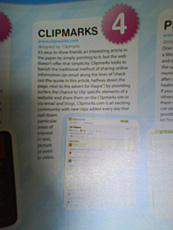 |
 |
| (+) maximize, 1200õ1600, JPEG |
(+) maximize, 1200õ1600, JPEG |
 |
 |
| (+) maximize, 1600õ1200, JPEG |
(+) maximize, 1600õ1200, JPEG |
 |
 |
| (+) maximize, 1600õ1200, JPEG |
(+) maximize, 1600õ1200, JPEG |
 |
 |
| (+) maximize, 1600õ1200, JPEG |
(+) maximize, 1600õ1200, JPEG |
 |
 |
| (+) maximize, 1600õ1200, JPEG |
(+) maximize, 1600õ1200, JPEG |
 |
 |
| (+) maximize, 1600õ1200, JPEG |
(+) maximize, 1600õ1200, JPEG |
 |
 |
| (+) maximize, 1600õ1200, JPEG |
(+) maximize, 1600õ1200, JPEG |
 |
 |
| (+) maximize, 1600õ1200, JPEG |
(+) maximize, 1600õ1200, JPEG |
Video
Video may be recorded in two resolutions (176x144, 128x96), File format is 3GP. Clip duration may be limited (up to 10 seconds) or unlimited. The quality of the clips beneath any criticism; so far this has been the weakest spot of all Sony Ericsson-branded devices.
Video sample 1(mp4, 0,7 mb) >>>
Video sample 2 (mp4, 0,9 mb) >>>
Video sample 3 (mp4, 0,1 mb) >>>
Video sample 4 (mp4, 1 mb) >>>
Video sample 5 (mp4, 1,2 mb) >>>
Video sample 6 (mp4, 0,9 mb) >>>
Video sample 7 (mp4, 1,7 mb) >>>
Preinstalled applications, games and themes
We won’t review the W910i’s standard feature pack, for it comprises all the goodies of the A200, which were given an in-depth close-up in a dedicated article. So here we will be focusing on the phone’s unique abilities and features.
The phone comes preinstalled with 5 different themes, all of them involving flash animation to some extent, and changing the looks of the main menu to a circle-shaped appearance or the matrix we are all used to.
There are three games available in the W910i - Lumines Block Challenge, Marble Madnes 3D (employs the motion sensor, you will need to move the ball around), V-Rally 3D. This roster is pretty interesting, especially the rally, which looks pretty decent.

Also you will find Audible here (uploads MP3 audio books, accesses your library), and Music Mate 4 (ever wanted to master some instruments?).
Back to the table of contents >>>
Music department
SensMe. In addition to its default Walkman 3rd edition pack of goods, the Sony Ericsson W910i comes with the SensMe functionality, which is currently absent from other phones, but will make it to the company’s portfolio in time. The advantage of this Media Manager is that it handles memory cards as well, so you don’t necessarily need a handset connected to your PC. On top of all that it can convert photos and video for your handset.
Is this SensMe functionality of any interest to us? Definitely yes. The tunes map features dots (your music tracks) showing you how particulars song stand on either of the two scales. You can move between these dots and every time you hover over one, it gets highlighted and played back right away. However the scope covers a couple of a dots (or songs, if you like), so by hitting the OK button you will compose a playlist with some mood- and speed-keyed tracks on it. You will really appreciate the phone’s ability to pick the most fitting music when you have another mood swing.
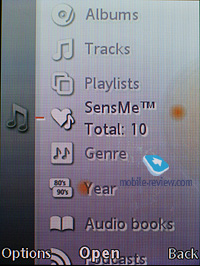
However you need to understand that this feature will really make the difference only if you have various music genres stored on your phone and you do have loads of tunes as well. And in case you feel content with a couple of albums from one artist you are very likely to find them residing in one of the quarters of the tunes map, so SensMe won’t make sense any more (pun intended). Also, we highly recommend 2 Gb plus memory cards – playlists get really different only with this much storage filled up with music.
Shake Control. Another thing setting the W910i apart from the previous models is the full-fledged Shake Control feature. There is nothing tricky to it – you tap and hold the Walkman key and then start shaking the phone – shake it forward to get it to jump to the next track, and pulling it backward will move you to the previous song. And if you just shake it around, the W910i will take it as a command to turn the shuffle mode on. Every time you shake it, you get some tactile feedback as well – the handset vibrates a little.
Apparently, this feature won’t be widely adopted. It is more likely to be appreciated by those who are into running or other sport-related activities, so they would love to jump between tracks on the fly. The youth might only want to play around with it for some time, but that’s it. The remote is a much better option for controlling music playback.
As for a couple of new filters available with the W910i, we can’t overlook the Time Machine that picks only tracks released in some particular year. More conventional categories include the lists of the most and the least popular songs. Unlike the Sony Ericsson W960i, this phone comes with no list of recently added or top-rated tracks. In terms of software, the Sony Ericsson W910i isn’t exactly a replica of the senior model – some features are still found only on the W960i. And since these are all complementary smarts, this differentiation makes no sense at all – it won’t be the deal breaker for consumers for sure.
Speakerphone mode. Used as a juke box, this handset doesn’t blow you away with quality, for it packs only one speaker that starts distorting your music as soon as you get to its top volume settings. So it is pretty loud, but this comes at the price of creaking sounds and generally worse sonic experience. The W910i is behind all offerings armed with stereo-speakers. Moreover, today’s Walkman range has no devices coming with two stereo-speakers onboard.
Walkman 3.0 rundown. Among the fundamental improvements over Walkman 2.0, the new version sports DRM 2.0 support as well as support for MTP, which makes for direct music transfers with Windows Media Player.
The handset locates all files and folders on the memory card, and then gets the necessary data from ID3-tags. Supported audio formats - MP3, AAC, AAC+, E-AAC+, WAV, WMA and m4a. There are no limitations on bit rates; you can also upload files with VBR. The company recommends using files with 192 Kbit/s bit rate.
In the music library, all saved tracks are classified by the following parameters:
- Artists – the application displays general list of artists in alphabetical order, you can carry out a fast search here;
- Albums – sorts by albums’ titles, search function is available as well;
- Tracks –general list of all tracks, sorting is conducted by tracks’ titles or ID3 tags;
- Genre – sorting, which uses various music styles, like Hip Hop, Jazz, Blues as criteria;
- My playlists – these are playlists, made up by user, that can be created both on the device and on PC, while viewing contents of the flash memory in USB Mass Storage mode; the handset also locates them when updates the library.
Unlike the second version of the player, while all transitions are still horizontal, they are designed in a slightly different matter, which won’t bother you, however. You won’t need to hit the buttons too many times to move about the player.
You can take advantage of the Repeat (one/all) playback mode. The W910i also features a progressive fast forward with customizable steps. You can’t pick any visualization (an animation instead of the album art) here.
If your phone is playing music and you are at the standby screen, bringing up the Media section will lead you to the player automatically.
The sonic experience delivered by the W910i hasn’t changed a bit compared to the previous models. With the five-brand equalizer you can create some settings of your own; the option of stereo widening is also available with the W910i.

The phone also boasts TrackID and an RDS-enabled FM-radio module (learn more about them in our dedicated write-up on A200).

Sound quality. The phone ships with the HPM-70 headset, which provides pretty good sound quality. In my opinion this model is neither better nor worse than other members of the Walkman line-up. And its 15-point volume level scale feels pretty sufficient.
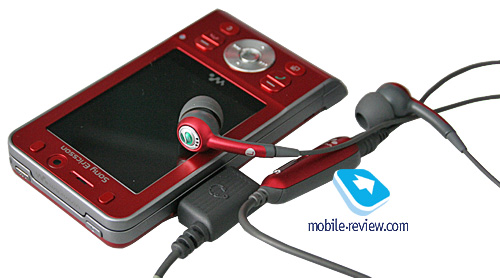

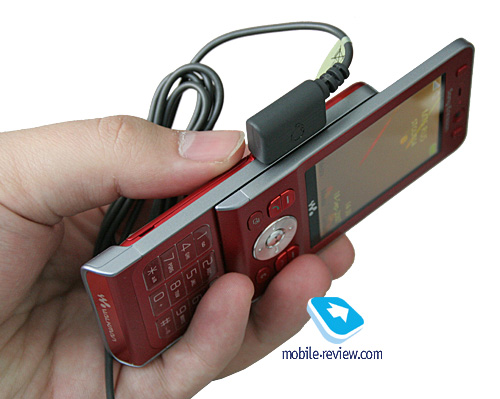
When it all started for music playing phones, this very concept was quite new, and the Walkman brand went up in ranks in no time. Hardware-wise, the W910i sports no dedicated chips for sound enhancement, and in the sense of sonic experience, rather than player’s functionality, all Sony Ericsson branded handsets turn out to be pretty much in the same boat.
While it made sense when the line-up had no real competition, with the development of Ultra Music from Samsung and Nokia’s XpressMusic, Walkman starts getting a run for its money. When we compared the sound quality delivered by the W910i with the Nokia 5310 and the Samsung i450, it was clearly behind both of them. Its bass level is less decent than that found on other solutions, the same goes for its top volume settings, and the equalizers found on the Nokia’s phone have greater impact on what you actually hear. It turns out that the Sony Ericsson’s product trumps them only with its software, whereas it comes short on the hardware front. Furthermore, those looking for superior sonic experience will have to look elsewhere – this flagship is definitely not for them.
RightMark Audio Analyzer tests:
General performance
Frequency response (from 40 Hz to 15 kHz), dB: |
+4.89, -2.06 |
Bad |
Noise level, dB (A): |
-33.2 |
Very bad |
Dynamic range, dB (A): |
81.7 |
Good |
THD, %: |
0.129 |
Average |
IMD, %: |
29.514 |
Very bad |
Stereo crosstalk, dB: |
-89.5 |
Excellent |
Intermodulation at 10 kHz, %: |
-1.#QO |
Excellent |
General performance: Average
Frequency response

Noise level

Alexander Dembovsky’s take on the W910i:
While the W910i may sound good, our RMAA tests gave us some disturbing results. That is, the W910i’s Frequency response is excessively distorted, plus its lower frequencies are too elevated. Putting it simply, this phone’s sound is nowhere near what we call “smooth”, and on top of that it artificially boosts its bass, which is pretty ragged already. Replacing the default earphones won’t do much good – the player is doing better with the bundled set of headphones plugged in, and what is more, the output signal’s volume isn’t that great either.
The Noise level characteristic of the W910i is also higher than that of stand-alone audio players, which is probably due to the adapter.
Back to the table of contents >>>
Sony Ericsson W910i vs Sony Ericsson W580i
Putting the W910i up against the W580i can make some sense, since these two will be considered as almost identical solutions in terms of functionality (at least at a glance) and might well end up on the same short list.
| |
Sony Ericsson W910i |
Sony Ericsson W580i |
| Size, weight |
99.5x50x12.5 mm, 86 grams |
99x47x14 mm, 94 grams |
| Display |
2.36 inches, QVGA, TFT, 262K |
2 inches, QVGA, TFT, 262K |
| Motion sensor |
Games, music, camera |
Games, music, sporty features (pedometer) |
| Software platform |
A200, JP-8 |
A100, JP-7 |
| Battery |
BST-39, 920 mAh, Li-Ion |
BST-38, 930 mAh, Li-Pol |
| Walkman version |
3.0 |
2.0 |
| Shake Control |
Three actions |
Shuffle only |
| Windows Media support |
Yes (plus DRM 2.0) |
Yes |
| Media section |
Yes |
No |
| Camera |
2 Mpix, CMOS, no autofocus |
2 Mpix, CMOS, no autofocus |
| Price |
370-400 Euro |
280-300 Euro |
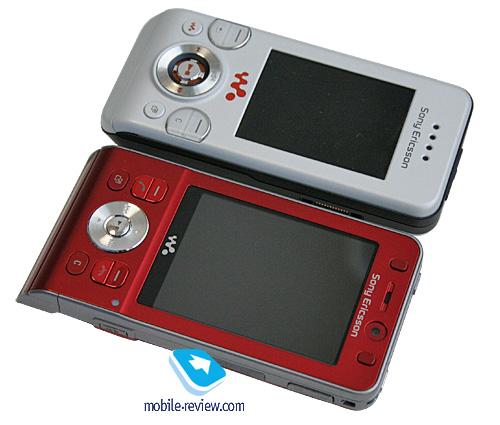
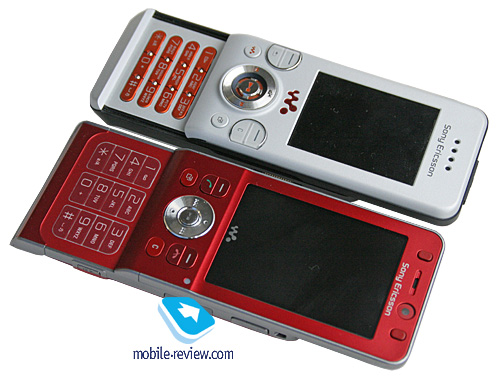
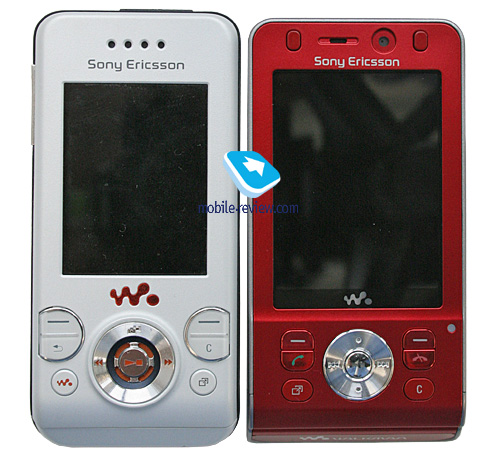
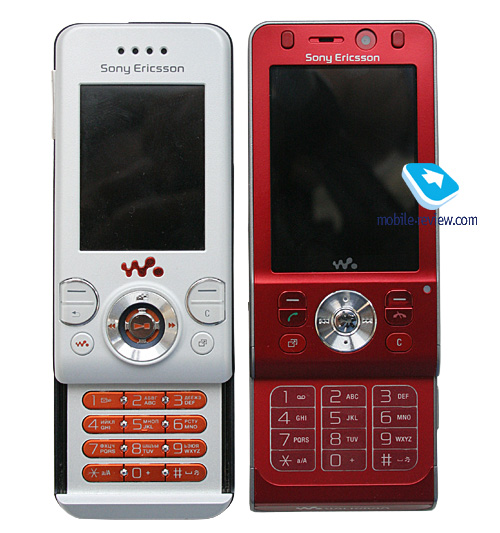

Back to the table of contents >>>
Competition
As fast as sound quality is concerned, the W910i is a clear outsider on the today’s market of music phones, it just doesn’t deliver. That’s why it is better to pay more attention to its form-factor and its fashion-savvy face. If you recall what this phone was supposed to rival in the first place, you will see that its closest competition on the market is the Samsung U600/U700. These aren’t music-minded solutions, by any means, but they have pretty much comparable options onboard plus 3.2 Mpix cameras. While they are behind the W910i software-wise, I doubt many rely on this when choosing a fashion-savvy phone. With their looks, Sony Ericsson and Samsung win a whole lot of consumers. But at the end of the day, this is nothing more than indirect competition.

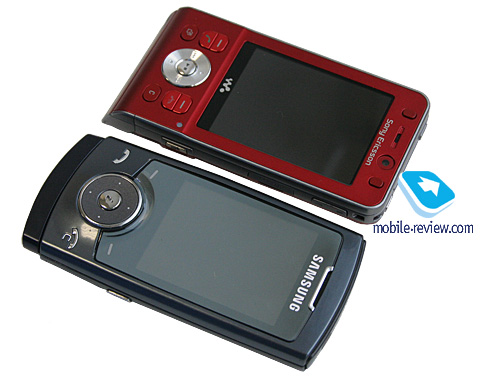
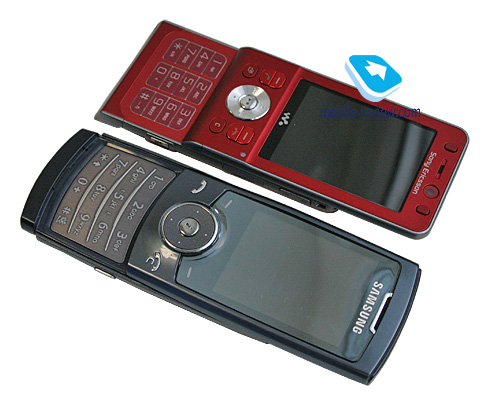
The Samsung F330 also has a lot of music related smarts, but its style is somewhat different and it targets a different audience. Don’t think of it as the W910i’s direct rival, on top of all that it will go for around 120 Euro less.
The Nokia N81 in its turn is in a completely different weight class, and doesn’t rival the W910i in any way. Put it this way to you – try tempting a Cooper Mini fan with a decent minivan. You can drive either of them, and they share a lot of things, and even have very similar price tags. But their philosophies and target audiences are so different.
The only phone the W910i might have a clash with is the Nokia 5610 – in some ways these two are quite similar. In my opinion, the Nokia’s phone is pretty much in line with the W910i in terms of its feature pack, retails for almost the same amount of money, and still trumps it with superior audio performance. Given their not-so-different price tags, the 5610 is a better way to go, yet its design is not much of an eye-grabber.
By now our readers might be already getting a feeling that the Sony Ericsson W910i is beyond competition and therefore can well become a bestseller. But as I see it, it is not the case here. This model will be quite successful all thanks to the brand power, but won’t get ultra-popular, just like the Sony Ericsson W850i. The market offers a ton of rivals for this very phone, and all these are fashion-savvy sliders, which debuted earlier and have already seen some price cuts. The W910i has forayed into a very crowded segment with a multitude of other offerings already in it, and there is so little room left for maneuvers.
Back to the table of contents >>>
Impressions
Despite its 72-chord polyphony, the W910i is no better than other Sony Ericsson branded phones in terms of audio performance. The loudspeaker is average volume-wise and provides pretty rich sound. The vibro alert is of moderate power or even slightly higher than that, but even this fact isn’t an excuse for the situations when it proves too weak to be felt. The reception part is in line with other products from the company, meaning that it is quite decent.
The handset is positioned as a music flagship and judged on its software holdings, it is exactly what the W910i is. I really liked the SensMe functionality, while Shake Control seemed to be more of a gimmick of no real use in real life. Regrettably, given the average sonic experience it delivers, we can’t really call it a true music-heavy solution. This, ridiculous as it may sound, though, is getting to be pretty much true of all Walkman-branded phones. Probably, after spotting the Walkman logo, some will imagine its sound-related marvels, but sadly these are only dreams and groundless thoughts. On every single blind test, the Sony Ericsson’s product ended up behind the Ultra Music and the XPressMusic solutions.
On balance, the Sony Ericsson W910i is a fashion-savvy phone, and that’s the most interesting part about it. Apparently, the matters of design are very taste-dependant, but the W910i is pretty smooth and will garner a lot of lovers. But don’t count on its music department, probably, it is a part of its halo of a fashion phone, but by no means a real merit of this particular phone (which is a pity – it would’ve been so much more enticing otherwise). The company needs to turn this negative trend around and add hardware sound enhancements apart from numerous software tweaks. Thankfully, Sony’s portfolio sports some of the most cutting-edge developments in this field, and dumping them would be next to a crime. If this matter will keep getting short shrift, in a year’s time the sales of Walkman-branded phones get on a downswing and they won’t be turning heads any more.
Retailing for 350-400 Euro, the Sony Ericsson W910i is an interesting fashion-inclined solution. The A200 platform comes up with such abilities as the Media menu, slide-shows, expanded set of basic settings and features. But, regrettably, the W910i isn’t much of a music phone.
SAR value for this model – 0.9 W/kg.
Related links
Back to the table of contents >>>
Eldar Murtazin ([email protected])
Translated by Oleg Kononosov ([email protected])
Published — 13 November 2007
Have something to add?! Write us... [email protected]
|
News:
[ 31-07 16:21 ]Sir Jony Ive: Apple Isn't In It For The Money
[ 31-07 13:34 ]Video: Nokia Designer Interviews
[ 31-07 13:10 ]RIM To Layoff 3,000 More Employees
[ 30-07 20:59 ]Video: iPhone 5 Housing Shown Off
[ 30-07 19:12 ]Android Fortunes Decline In U.S.
[ 25-07 16:18 ]Why Apple Is Suing Samsung?
[ 25-07 15:53 ]A Few Choice Quotes About Apple ... By Samsung
[ 23-07 20:25 ]Russian iOS Hacker Calls It A Day
[ 23-07 17:40 ]Video: It's Still Not Out, But Galaxy Note 10.1 Gets An Ad
[ 19-07 19:10 ]Another Loss For Nokia: $1 Billion Down In Q2
[ 19-07 17:22 ]British Judge Orders Apple To Run Ads Saying Samsung Did Not Copy Them
[ 19-07 16:57 ]iPhone 5 To Feature Nano-SIM Cards
[ 18-07 14:20 ]What The iPad Could Have Looked Like ...
[ 18-07 13:25 ]App Store Hack Is Still Going Strong Despite Apple's Best Efforts
[ 13-07 12:34 ]Infographic: The (Hypothetical) Sale Of RIM
[ 13-07 11:10 ]Video: iPhone Hacker Makes In-App Purchases Free
[ 12-07 19:50 ]iPhone 5 Images Leak Again
[ 12-07 17:51 ]Android Takes 50%+ Of U.S. And Europe
[ 11-07 16:02 ]Apple Involved In 60% Of Patent Suits
[ 11-07 13:14 ]Video: Kindle Fire Gets A Jelly Bean
Subscribe
|

